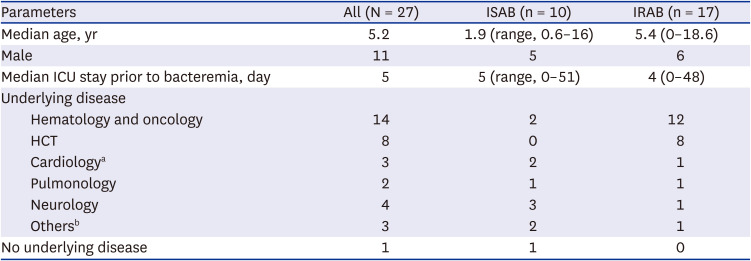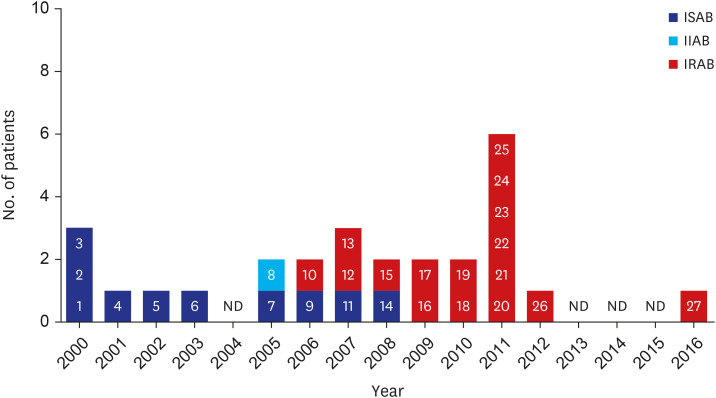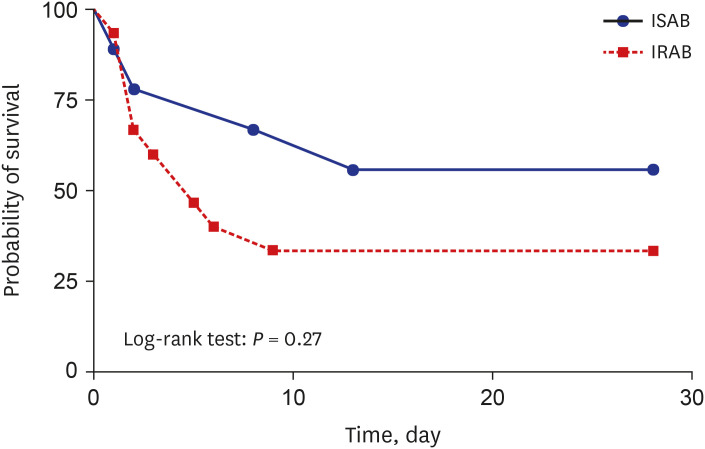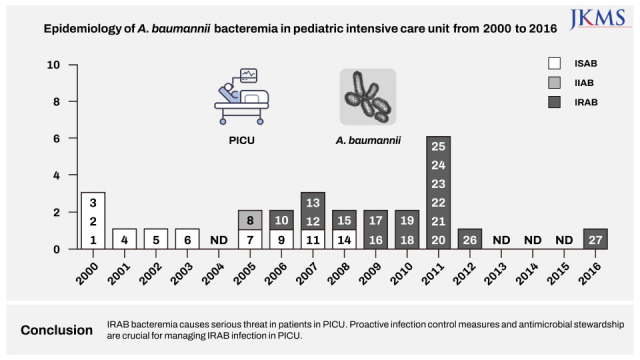1. Lakshmi KS, Jayashree M, Singhi S, Ray P. Study of nosocomial primary bloodstream infections in a pediatric intensive care unit. J Trop Pediatr. 2007; 53(2):87–92. PMID:
17151083.

2. Le NK, Hf W, Vu PD, Khu DT, Le HT, Hoang BT, et al. High prevalence of hospital-acquired infections caused by Gram-negative carbapenem resistant strains in Vietnamese pediatric ICUs: a multi-centre point prevalence survey. Medicine (Baltimore). 2016; 95(27):e4099. PMID:
27399106.
3. Lake JG, Weiner LM, Milstone AM, Saiman L, Magill SS, See I. Pathogen distribution and antimicrobial resistance among pediatric healthcare-associated infections reported to the National Healthcare Safety Network, 2011-2014. Infect Control Hosp Epidemiol. 2018; 39(1):1–11. PMID:
29249216.

4. Vila J, Bonomo RA. 46th Interscience Conference on Antimicrobial Agents and Chemotherapy. Future Microbiol. 2007; 2(1):9–12. PMID:
17661671.

5. Endo S, Yano H, Hirakata Y, Arai K, Kanamori H, Ogawa M, et al. Molecular epidemiology of carbapenem-non-susceptible
Acinetobacter baumannii in Japan. J Antimicrob Chemother. 2012; 67(7):1623–1626. PMID:
22447879.

6. Evans BA, Amyes SG. OXA β-lactamases. Clin Microbiol Rev. 2014; 27(2):241–263. PMID:
24696435.

7. Lee HY, Hsu SY, Hsu JF, Chen CL, Wang YH, Chiu CH. Risk factors and molecular epidemiology of
Acinetobacter baumannii bacteremia in neonates. J Microbiol Immunol Infect. 2018; 51(3):367–376. PMID:
28830746.

8. Sultan AM, Seliem WA. Identifying risk factors for healthcare-associated infections caused by carbapenem-resistant
Acinetobacter baumannii in a neonatal intensive care unit. Sultan Qaboos Univ Med J. 2018; 18(1):e75–e80. PMID:
29666685.
9. Hong KB, Oh HS, Song JS, Lim JH, Kang DK, Son IS, et al. Investigation and control of an outbreak of imipenem-resistant
Acinetobacter baumannii infection in a pediatric intensive care unit. Pediatr Infect Dis J. 2012; 31(7):685–690. PMID:
22466324.

10. Ko KS, Kuwahara T, Haehwa L, Yoon YJ, Kim BJ, Lee KH, et al. RNA polymerase beta-subunit gene (
rpoB) sequence analysis for the identification of
Bacteroides spp. Clin Microbiol Infect. 2007; 13(1):48–54. PMID:
17184287.

11. La Scola B, Gundi VA, Khamis A, Raoult D. Sequencing of the
rpoB gene and flanking spacers for molecular identification of
Acinetobacter species. J Clin Microbiol. 2006; 44(3):827–832. PMID:
16517861.

12. Clinical and Laboratory Standards Institute (CLSI). CLSI Supplement M100S. Performance Standards for Antimicrobial Susceptibility Testing. 26th ed. Wayne, PA, USA: CLSI;2016.
13. Park YK, Choi JY, Jung SI, Park KH, Lee H, Jung DS, et al. Two distinct clones of carbapenem-resistant
Acinetobacter baumannii isolates from Korean hospitals. Diagn Microbiol Infect Dis. 2009; 64(4):389–395. PMID:
19631092.

15. Bartual SG, Seifert H, Hippler C, Luzon MA, Wisplinghoff H, Rodríguez-Valera F. Development of a multilocus sequence typing scheme for characterization of clinical isolates of
Acinetobacter baumannii
. J Clin Microbiol. 2005; 43(9):4382–4390. PMID:
16145081.

16. Feil EJ, Smith JM, Enright MC, Spratt BG. Estimating recombinational parameters in
Streptococcus pneumoniae from multilocus sequence typing data. Genetics. 2000; 154(4):1439–1450. PMID:
10747043.

17. Park YK, Jung SI, Park KH, Kim DH, Choi JY, Kim SH, et al. Changes in antimicrobial susceptibility and major clones of
Acinetobacter calcoaceticus-baumannii complex isolates from a single hospital in Korea over 7 years. J Med Microbiol. 2012; 61(Pt 1):71–79. PMID:
21852525.

18. Rhomberg PR, Jones RN. Summary trends for the Meropenem Yearly Susceptibility Test Information Collection Program: a 10-year experience in the United States (1999-2008). Diagn Microbiol Infect Dis. 2009; 65(4):414–426. PMID:
19833471.

19. Kim D, Ahn JY, Lee CH, Jang SJ, Lee H, Yong D, et al. Increasing resistance to extended-spectrum cephalosporins, fluoroquinolone, and carbapenem in Gram-negative bacilli and the emergence of carbapenem non-susceptibility in
Klebsiella pneumoniae: analysis of Korean Antimicrobial Resistance Monitoring System (KARMS) data from 2013 to 2015. Ann Lab Med. 2017; 37(3):231–239. PMID:
28224769.

20. Xu A, Zheng B, Xu YC, Huang ZG, Zhong NS, Zhuo C. National epidemiology of carbapenem-resistant and extensively drug-resistant Gram-negative bacteria isolated from blood samples in China in 2013. Clin Microbiol Infect. 2016; 22(Suppl 1):S1–S8. PMID:
26846351.

21. Thatrimontrichai A, Apisarnthanarak A, Chanvitan P, Janjindamai W, Dissaneevate S, Maneenil G. Risk factors and outcomes of carbapenem-resistant
Acinetobacter baumannii bacteremia in neonatal intensive care unit: a case-case-control study. Pediatr Infect Dis J. 2013; 32(2):140–145. PMID:
22935872.

22. Garcia Casallas JC, Robayo-Amortegui H, Corredor-Rozo Z, Carrasco-Márquez AM, Escobar-Perez J. Bacteremia by colistin-resistant Acinetobacter baumannii isolate: a case report. J Med Case Reports. 2019; 13(1):141.
23. Jeon H, Kim S, Kim MH, Kim SY, Nam D, Park SC, et al. Molecular epidemiology of carbapenem-resistant
Acinetobacter baumannii isolates from a Korean hospital that carry bla
OXA-23
. Infect Genet Evol. 2018; 58:232–236. PMID:
29307769.

24. Smith CA, Antunes NT, Stewart NK, Toth M, Kumarasiri M, Chang M, et al. Structural basis for carbapenemase activity of the OXA-23 β-lactamase from
Acinetobacter baumannii
. Chem Biol. 2013; 20(9):1107–1115. PMID:
24012371.

25. Karah N, Sundsfjord A, Towner K, Samuelsen Ø. Insights into the global molecular epidemiology of carbapenem non-susceptible clones of
Acinetobacter baumannii
. Drug Resist Updat. 2012; 15(4):237–247. PMID:
22841809.

26. Kim DH, Jung SI, Kwon KT, Ko KS. Occurrence of diverse AbGRI1-type genomic islands in
Acinetobacter baumannii global clone 2 isolates from South Korea. Antimicrob Agents Chemother. 2017; 61(2):e01972-16. PMID:
27895018.

27. Kim MH, Jeong H, Sim YM, Lee S, Yong D, Ryu CM, et al. Using comparative genomics to understand molecular features of carbapenem-resistant
Acinetobacter baumannii from South Korea causing invasive infections and their clinical implications. PLoS One. 2020; 15(2):e0229416. PMID:
32084241.
28. Lampati L, Maggioni E, Langer M, Malacarne P, Mozzo R, Pesenti A, et al. Can routine surveillance samples from tracheal aspirate predict bacterial flora in cases of ventilator-associated pneumonia? Minerva Anestesiol. 2009; 75(10):555–562. PMID:
19461563.
29. Karageorgopoulos DE, Falagas ME. Current control and treatment of multidrug-resistant
Acinetobacter baumannii infections. Lancet Infect Dis. 2008; 8(12):751–762. PMID:
19022191.

30. An JH, Kim YH, Moon JE, Jeong JH, Kim SH, Kang SJ, et al. Active surveillance for carbapenem-resistant
Acinetobacter baumannii in a medical intensive care unit: can it predict and reduce subsequent infections and the use of colistin? Am J Infect Control. 2017; 45(6):667–672. PMID:
28242072.










 PDF
PDF Citation
Citation Print
Print




 XML Download
XML Download